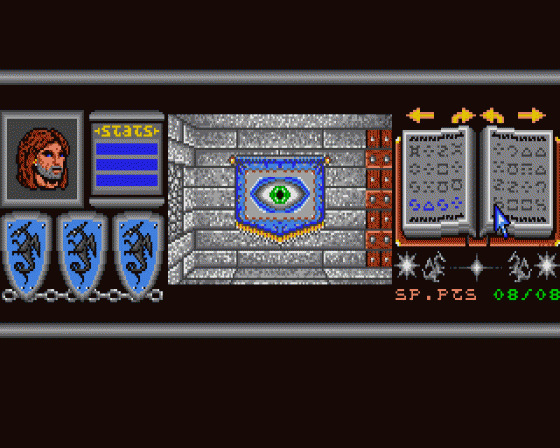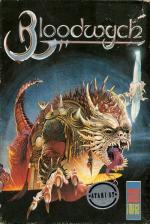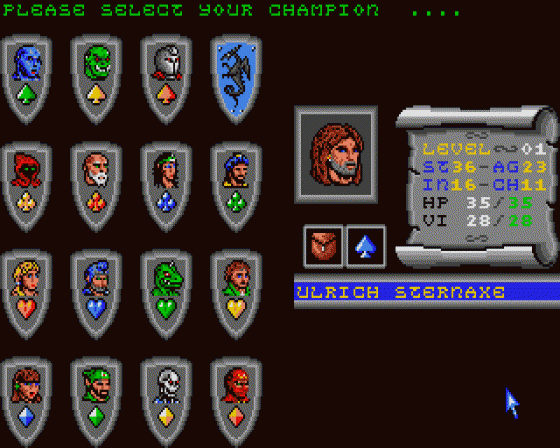
ST Format
 1st September 1989
1st September 1989
Bloodwych
A dark and foreboding cloud of fear hangs over the people of Bloodwych, for the demon Behemoth entombed within the great castle is once again beginning to awaken, soon to rise again and bring famine, pestilence, and death to the land.
A pretty tough spot for any unsuspecting peasant to find himself in, but all hope is not lost for, as legend would have it, the unification of the crystals of Sanguis which also lie deep within the castle of Bloodwych will seal Behemoth in his prison forever. If only they can find a chap or two for the job!
Imagine the classic Dungeon Master and add two player simultaneous action and a wealth of character/monster interaction and you are beginning to get a picture of what Bloodwych is all about.

The screen is split horizontally with each half showing the stats, options and a DM-style 3D perspective view for each character.
On the right of the screen is a set of icons that gives access to the standard options you would expect t find in a role-playing game; fighting, inventory, movement and, of course, spells.
On the left of each half is a portrait of the character you are playing; a stats bar that shows how fit you are and three shields bearing a small picture of any other characters you have in your bold adventuring party (you can have up to four). Click on the stats box and all of this is replaced by icons for pausing/saving the game etc and, most importantly, the communication menu.

Your original character is chosen from a menu at the beginning of the game. A large variety of character races are available, from humans and elves to skeletons and lizard men and there are four character classes; warrior, thief, wizard and adventurer. Warriors have high strength, thieves high agility, wizards high intelligence and lots of magic points and adventurers are charismatic good all rounders.
Once your character is chosen, the quest begins. Each character has its own starting position within the castle and these can be several dungeon levels apart, so be careful who you choose if you wish to meet with the other player's party without too much exploring first.
On your travels you will meet other inhabitants of the castle, some friendly, some not so friendly, and this is where the game's unique communication menu comes into play. The menu gives a wide range of options from boasts, threats and small talk to trade and information gathering and the programmers have given every individual character its own unique personality. It is this, even more than the game's two player DM style, that makes it stand leagues ahead of the already stiff competition.

Conversation with the natives is the only way to recruit new characters to your party and the only way to gain those useful bits of local gossip that make life in the dungeon and your search for the crystals so much easier. Be careful who you approach though, for you are just as likely to get a sword in the belly as a juicy morsel of information.
The game's spell system is also worthy of note. No jumbling together of meaningless runes or fumbling around for obscure spell components here, just click on your spell book and thumb through the pages (a very nice graphical touch as the pages flip over as you browse) until you find your chosen magic and once selected, a star-shaped trigger icon appears on the main menu and it's ready for use.
Spells become beasier to cast as you advance in character level, but at first many spells have a good chance of failing altogether, however, this can be compensated for by spending more than the required minimum spell points, if you have accumulated enough of them.
Effects

Dungeon graphics are very similar to those in Dungeon Master, if on a smaller scale, with rooms and corridors of grey stone or wooden boards fading into the gloomy darkness ahead.
Movement is also similar, working in a stepped effect much like taking a photograph with every stride you take. Animation of the character is also somewhat limited with the odd swing of the arms being about all you get. Despite this the overall effect manages to exude the medieval menace required.
Sound is limited to the odd spot effect but these are well placed, unobtrusive and add to the game's atmosphere.
Conclusion

Two player DM is not something to be sniffed at, but add to this the brilliant communications system, character personality profiles and the wonderfully simple but effective spell system and you're looking at one hell of a hot piece of adventuring software.
Bloodwych represents the way forward for computer role playing and though the ideas used in the game may not be very original, their implementation is easily the best yet seen on an ST.
With a vast castle to explore and a whole host of unique game options you and a friend are in grave danger of long sleepless nights pounding the path of fear in search of those ever elusive crystals of Sanguis.








